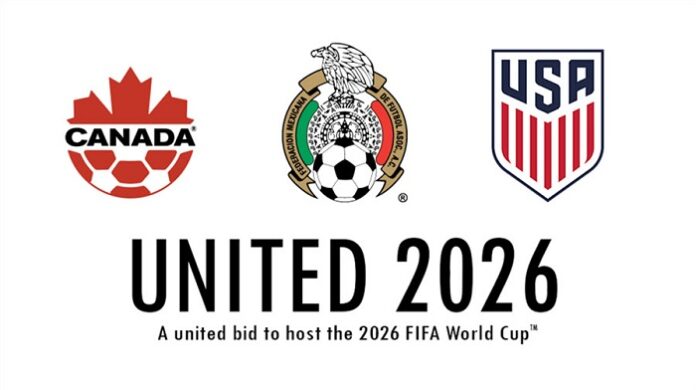The 2022 FIFA World Cup is all set to take place in Qatar later this year, with fans across the globe jostling to finalise their plans for the first global finals in the Middle East.
The Qatar World Cup is set to take place at eight venues in the Gulf nation, all within a 50km radius of Doha.
That should make it fairly comfortable for fans and teams at the tournament. This can’t be said about the next destination for the FIFA World Cup: the USA, Canada and Mexico.
North America has been chosen to host the next global finals and 16 venues for the showpiece event were announced by the governing body on Friday.
Hosting the World Cup across the length and breadth of the US and in neighbouring countries poses a unique challenge – distance and time zones.
Your #FIFAWorldCup 2026 Host Cities:
🇺🇸Atlanta
🇺🇸Boston
🇺🇸Dallas
🇲🇽Guadalajara
🇺🇸Houston
🇺🇸Kansas City
🇺🇸Los Angeles
🇲🇽Mexico City
🇺🇸Miami
🇲🇽Monterrey
🇺🇸New York / New Jersey
🇺🇸Philadelphia
🇺🇸San Francisco Bay Area
🇺🇸Seattle
🇨🇦Toronto
🇨🇦Vancouver— FIFA World Cup (@FIFAWorldCup) June 16, 2022
The United States is a vast country, with nine timezones and a difference of three hours from coast to coast. Add to the mix matches in Mexico and Canada, and the enormity of the task becomes clear.
Fifa knew about the challenges when it announced the host cities in Atlanta, Boston, Dallas, Houston, Kansas City, Los Angeles, Miami, New Jersey, Philadelphia, San Francisco, Seattle (US), Guadalajara, Mexico City, Monterrey (Mexico) and Toronto, Vancouver (Canada).
Fifa president Gianni Infantino said the governing body was looking at basing teams in regional “clusters” to minimise travel.
“When you’re dealing with such a large region as North America we need to care about the fans and make sure that teams are playing in clusters, that fans and teams don’t have to travel crazy distances,” Infantino said.
The World Cup is coming to Kansas City!#HostCity2026 // #FIFAWorldCup pic.twitter.com/2bVivo9uFK
— Kansas City Royals (@Royals) June 16, 2022
For example, the distance between San Fransisco and Boston is a little under 5,000km by road and six-and-a-half hours by flight. The distance between Vancouver and New York is around 4,800 km. Mexico City is closer to Central America, which will make travel a major factor at some point for the teams, fans and the tournament contingent.
Matches in the US will be staged at venues that are home to NFL teams. Eight of the 11 US stadiums have artificial turf and have promised to install temporary grass. Some venues cannot currently fit the dimensions required for football matches – 68mX105m field – and will require renovations to remove seats near the sidelines.
This World Cup will also see the number of participating teams increase from 32 to 48 as the tournament returns to North America for the first time since USA ’94.
The 1994 tournament set records with a 3.59 million total attendance and the average of 68,991. The capacities of the US stadiums for 2026 are all 60,000 and higher.
Full list of World Cup 2026 venues and their capacity
Furthermore, it will be the first World Cup to boast 48 qualified teams following FIFA’s vote in 2017 to expand the field from 32 sides, which had been the standard since France 1998.
In this new format, 16 groups of three teams will compete with the top two teams from each group advancing to a Round of 32, which will be single elimination all the way through to the final.
All in all, 80 matches will be spread across the 20 venues, with the U.S. hosting 60 games — including the quarterfinals, semifinals and final – and Mexico/Canada each taking 10 matches.
Philly is now a host city for the 2026 FIFA World Cup. This video says it all! #FIFAWorldCup pic.twitter.com/kBQwD5gvJl
— Kerri Corrado (@KerriCorrado) June 16, 2022
USA
- SoFi Stadium, Los Angeles. Capacity 70,000
- MetLife Stadium, New Jersey. Capacity 82,500
- AT&T Stadium, Dallas. Capacity 80,000
- Hard Rock Stadium, Miami. Capacity 65,000
- Arrowhead Stadium, Kansas City. Capacity 76,000
- Mercedes-Benz Stadium, Atlanta. Capacity 71,000
- Gillette Stadium, Boston. Capacity 65,000
- NRG Stadium, Houston. Capacity 72,000
- Lincoln Financial Field, Philadelphia. Capacity 67,000
- Levi’s Stadium, San Francisco Bay Area. Capacity 68,000
- Lumen Field, Seattle. Capacity 72,000
Mexico
- Azteca Stadium, Mexico City. Capacity 87,000
- Estadio Akron, Guadalajara. Capacity 46,000
- Estadio BBVA, Monterrey. Capacity 51,000
Canada
- BMO Field, Toronto. Capacity 30,000
- BC Place, Vancouver. Capacity 54,000




